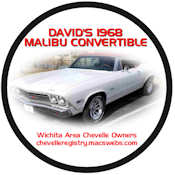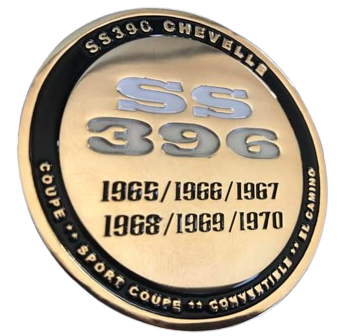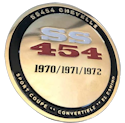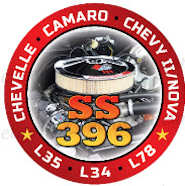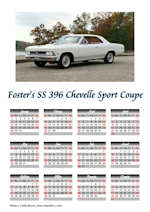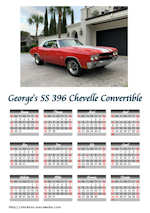How To Determine Rear End Gear Ratio If Suspect
How to determine your rear end gear ratio without removing cover.
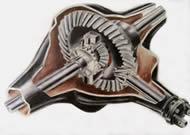
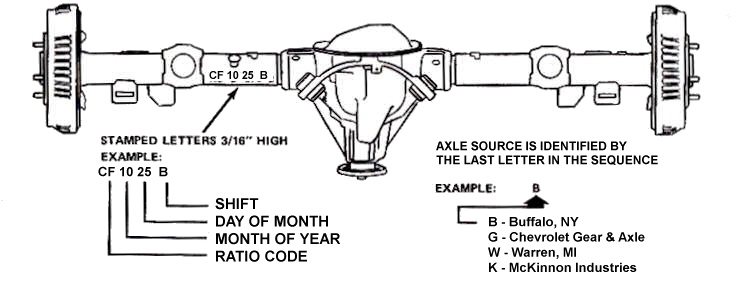
1964-1969 rear end example
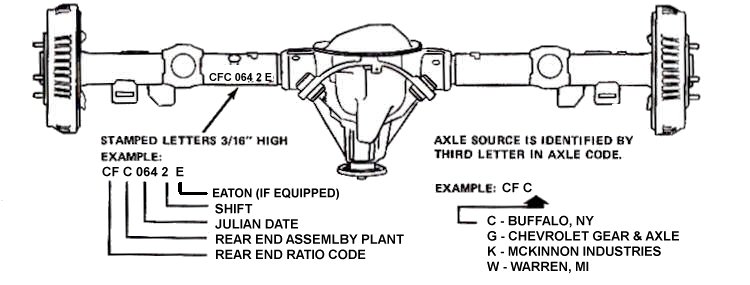
1970-1972 rear end example
If you can read the stamped alphanumeric characters stamped on the rear end axle housing, you can look up your rear end gear ratio here. Pick your Chevelle's year from the menu bar and scroll down to that year's "Rear Axle Codes" link. If you cannot find the characters stamped on the rear end axle housing, suspect the rear end gear has been changed, or you are running a different size wheel/tire than was original equipment on the car, you can perform the action below to approximate your final rear end gear ratio.
- Safety first! Place a chock (a block of wood will do in a pinch) in front of the front tires so the car does not move forward and slide off the jack stands. Raise (preferably with a hydraulic jack) the rear tires off the ground, place a jack stand under the frame and lower the jack onto the jack stands confirming the tires are still off the ground.
- How to determine if you have a limited slip rear end.
- With both rear tires off the ground rotate one of the two rear tires. If the opposite tire turns the same direction or doesn't turn at all, then the rear end is a limited slip rear end. If the opposite tires turns the opposite direction, then it's probably an open (non-limited slip) rear axle.
- For a non-Positraction rear end only one tire needs to be off the ground:
- Turn the rear tire a quarter turn counterclockwise (to the left) to remove any slack in the drivetrain.
- With a piece of chalk or masking tape, mark an area lengthwise along the driveshaft that can easily be seen from the side of the car and make a corresponding mark on the tire as close to the centerline (vertically) as possible for reference (6 o'clock or 12 o'clock position).
- Rotate the tire clockwise or counterclockwise TWO revolutions and count the number of times the mark on the driveshaft rotates for two full revolutions of the tire.
- The number of rotations of the driveshaft will help determine your final rear end gear ratio.
- For example, if the driveshaft rotates about 3 full turns, your final rear end gear ratio is probably 3.07:1 (12-bolt) or 3.08:1 (10-bolt); 3 1/3 driveshart rotations for one full rotation of the tire, your final rear end ratio would be about 3.31:1; 3 3/4 driveshaft roations would be about 3.73:1; 2 3/4 driveshaft rotations would be about 2.73:1.
- Naturally you can rotate the tire any even number of times while counting the driveshaft revolutions - just be sure to divide the numbers accordingly. If you turn the rear tire SIX times instead of TWO, you must divide the driveshaft rotations by THREE since SIX is three times greater than TWO.
- For a Positraction rear end both tires need to be off the ground:
- The same procedure is applicable for a limited slip (GM's trademark name is "Positraction") only ONE revolution of the rear tire is needed. Naturally you can rotate the rear tires as many times as you like - just be sure to divide the driveshart rotations by the same number.
There any any number of online calculators to help you determine your speed at any given RPMs knowing the (1) transmission, (2) tire size, and (3) final rear end ratio. Knowing any two of the three can help you find the third. If you know your tire size and approximate RPM at a given speed, you can play with the rear end gear ratio number to determine your overall rear end gear ratio.

 Club Newsletters
Club Newsletters Club Minutes
Club Minutes Member News
Member News Non-WACO Events &
Local Shows
Non-WACO Events &
Local Shows Midwest Chevelle Regional
Shows
Midwest Chevelle Regional
Shows Other Chevelle Clubs
Other Chevelle Clubs WACO Events
WACO Events Club Project 1967 Chevelle
Club Project 1967 Chevelle Member's Cars
Member's Cars Mark Ellsworth's Project
El Camino
Mark Ellsworth's Project
El Camino Club Sponsors
Club Sponsors Local Services
Local Services Doug's Corner
Doug's Corner Tech Links
Tech Links Tech Videos
Tech Videos



